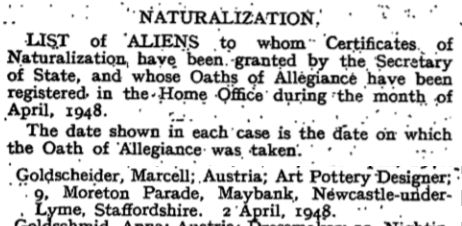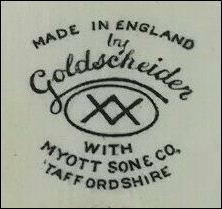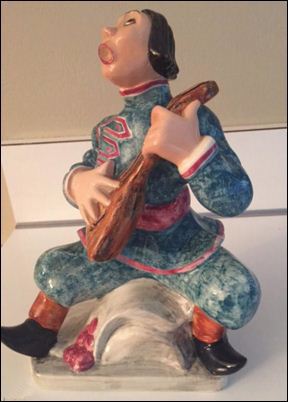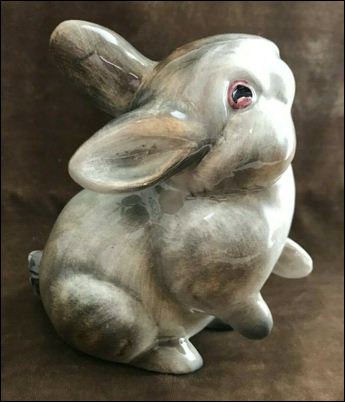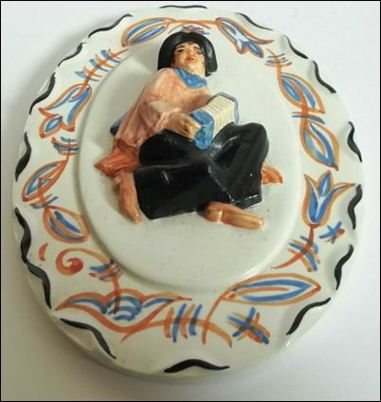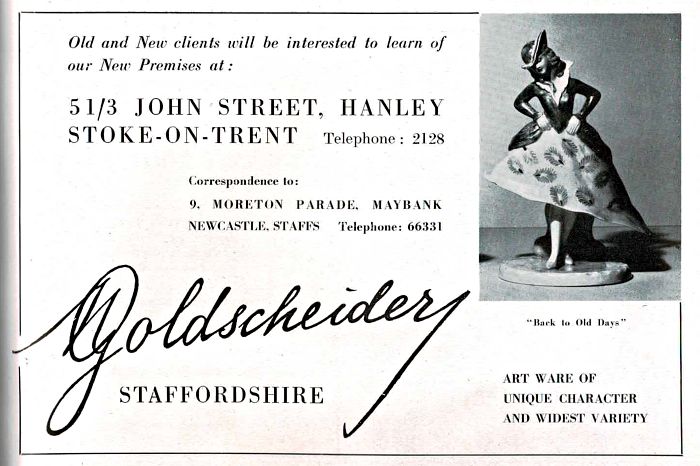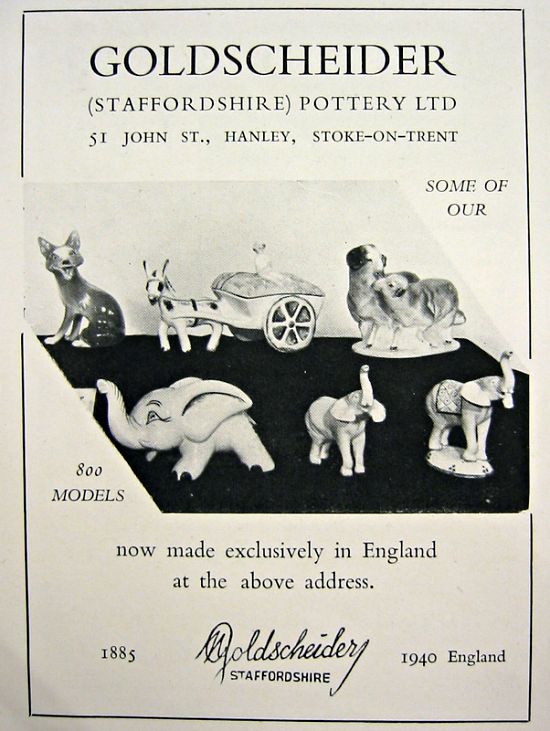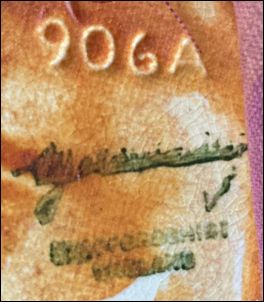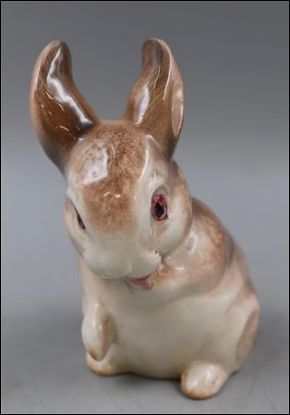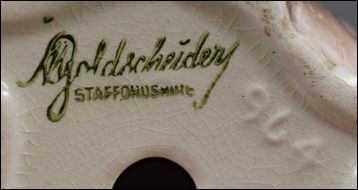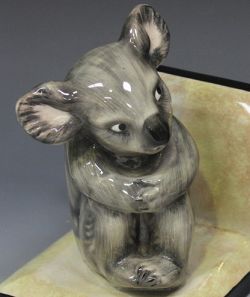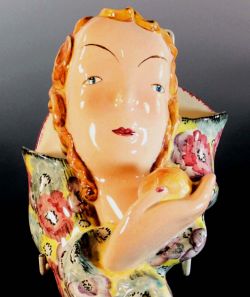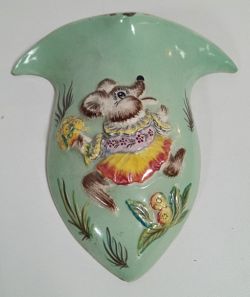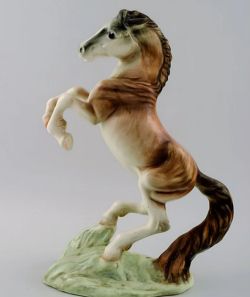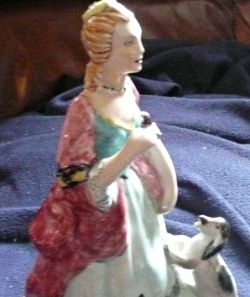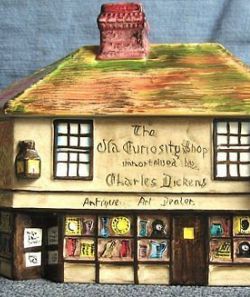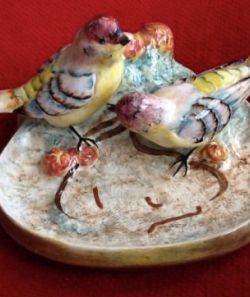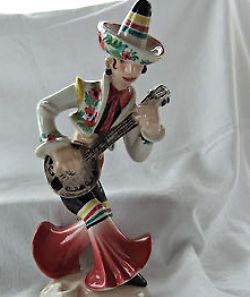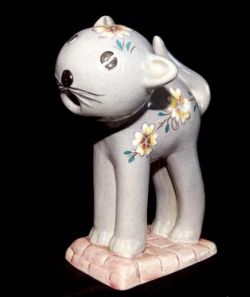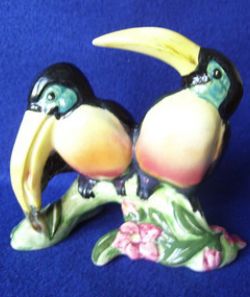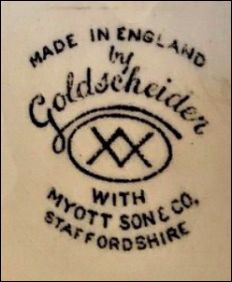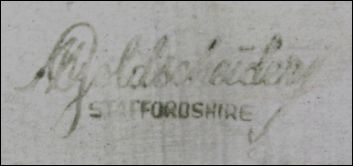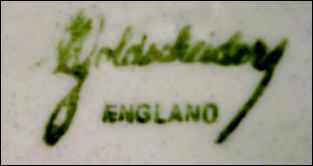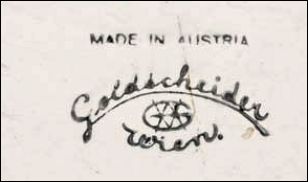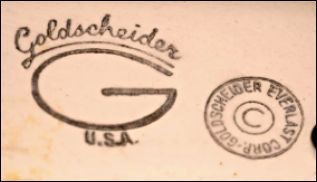|
Article
translated from the German:
"Marcell and Rosemarie Goldscheider decided to emigrate to England and left Austria with their daughter Inge in early 1939. In the factories in Staffordshire, which Marcel knew from his apprenticeship, they saw an opportunity to continue producing ceramic models at a high level.
In 1940, Marcell found support at the Myott, Son & Co. factory. The Myott brothers provided him with production space for an independent model line on their factory premises, the Alexander Potteries in Hanley, a suburb of Stoke-on-Trent. In 1941, the model range consisted of figurines, animal sculptures, lamps, wall masks, and decorative objects for dining tables and desks. All manufactured objects were intended for export, with the figurative ceramics particularly aimed at the American market. Among the wall masks were several Austrian models in the style of Rudolf Knörlein, as well as, for example, a new wall mask of Winston Churchill. Candlesticks and a cigarette box with a relief of a woman's face were also part of the range. By the end of 1942, the range already included 300 models and over 600 patterns. The figurines represented the grotesque, historical, and religious themes and were sold in both richly decorated designs and in white, matte, or light colors to cover a more affordable segment.
Within a few years, Marcel's work was respected in North and South America as well as on the British market, and as the Pottery Gazette wrote in January 1945, the figurines displayed "superb technical boldness." A set of figurines called "Cries of Old London," for example, depicts various ladies engaged in various activities in Victorian-era clothing, created using a new coloring technique. Other models depict prominent, mostly historical figures, vases with raised reliefs, bowls for fruit or salad, as well as jugs and cups—all hand-painted.
Many of the skilled workers employed by Marcel came from the Stoke-on-Trent Art School and received further training from him in modeling, molding techniques, and decoration. In England, too, Marcel pursued the goal of combining the creative individuality of the artist with a comprehensive, expert knowledge of production and involving the artist in the various stages of production.
By 1949, the product range comprised 750 models, and Marcel exhibited at the British Industry Fair (BIF), which had long been a popular event, as well as at the Copenhagen Fair. In addition to producing at Myott, Marcel also designed his own models during this time, which he created in his private studio in Newcastle.
On August 24, 1949, the Myott factory was destroyed by fire. During the rebuilding of the factory, the Myott owners decided to discontinue the figurative and artistic ceramics division and to focus solely on the production of Myott's globally popular tableware sets.
In September 1950, the English trade journal "The Pottery and Glass Trade Review" announced that, after ten years of collaboration, Marcel Goldscheider would now be solely responsible for production in his Newcastle studio. In December 1950, Marcel moved into new premises in Hanley, Stoke-on-Trent.
Marcel, whose company was called "Goldscheider Art Pottery," also attracted attention with a new series of models. Famous buildings such as St. Paul's Cathedral, Windsor Castle, the Tower of London, and Tower Bridge, as well as the "Old Curiosity Shop" described by Charles Dickens, were to be sold as part of festivities or as souvenirs in general. Marcel pointed out that these objects were not only decorative but also "useful," as some could be used as tobacco tins, fruit containers, or jewelry boxes. Several figurines were also created based on stories by Charles Dickens.
In June 1953, a name change was announced, and the company was registered as Goldscheider (Staffordshire) Pottery, Ltd. Marcel exported his earthenware and bone china models worldwide and exhibited in showrooms in London, Stockholm, Wellington, Montevideo, Paris, Toronto, and Sydney. In Paris, the showrooms were located on Rue de Paradis, the street where his family had a bronze factory for decades. Agents representing him could also be found in Hong Kong, Venezuela, and Cuba, where he was represented by Ernesto Samson, who had represented both Marcel and Walter's models even before the war.
By the mid-1950s, the ceramics industry was in crisis. Cheap copies from Japan and other countries were taking over the market, export sales were declining, and plastic products were also viewed as a threat. The market was described as stagnating, with sales of bone china figurines suffering the most due to increased taxes. During this difficult time, Marcel's participation in trade fairs was likely also reduced due to his age; at almost 70, he was too tired of traveling. Marcel Goldscheider died on April 23, 1964, in Worthing, Sussex, on the south coast of England."
Article
source acknowledgement: Goldscheider
- the World Brand of Ceramics |
![]()
